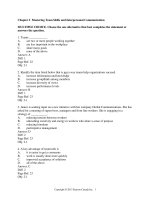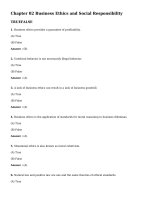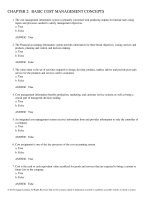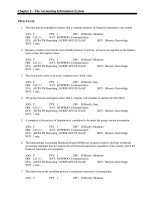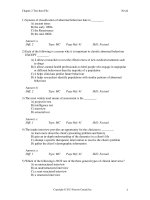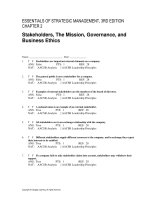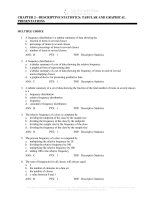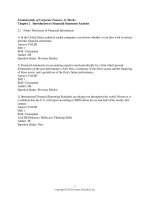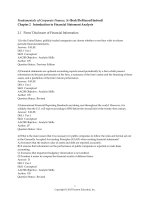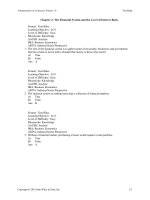Fundamentals of investments canadian 3rd edition jordan test bank
Bạn đang xem bản rút gọn của tài liệu. Xem và tải ngay bản đầy đủ của tài liệu tại đây (431.2 KB, 33 trang )
02
Student: ___________________________________________________________________________
1.
The __________ return is the average projected return of an asset in different states of the economy.
A. Variable
B. Realized
C. Portfolio
D. Expected
E. Potential
2.
A combination of assets held by an investor is known as a(n) __________.
A. Opportunity set
B. Efficient asset
C. Markowitz selection
D. Portfolio
E. Minimum variance option
3.
The portfolio weight of an asset is the
A. Market value of that asset expressed as a percentage of the asset's initial cost
B. Market value of that asset expressed as a percentage of the total portfolio value
C. Cost invested in that asset expressed as a percentage of the total cost of the portfolio
D. Number of shares held in that asset divided by the total number of shares owned
E. Return on the asset as a fraction of the entire return on the portfolio
4.
The reduction in risk realized when a portfolio is invested in a variety of assets is called
A. Stock selection
B. Diversification
C. Correlation
D. Stock management
E. Opportunity investing
5.
__________ is the extent to which the returns on two assets move together.
A. Standard deviation
B. Variance
C. Correlation
D. Efficiency
E. Tangency
6.
__________ is a statistical measure of the degree to which two variables (e.g. securities' returns) move
together.
A. Covariance
B. Variance
C. Skewness
D. Coefficient of variation
E. Tangency
7.
The manner in which an investor spreads his portfolio across a variety of securities is called
A. The efficient frontier
B. Correlation
C. Minimization
D. Asset allocation
E. The investment opportunity set
8.
All possible risk-return combinations available from portfolios consisting of different group of assets are
the __________.
A. efficient frontier
B. investment opportunity set
C. portfolio set
D. correlation
E. capital asset pricing model
9.
A(n) __________ portfolio offers the lowest risk for a given level of return or it generates the highest
possible return for a given level of risk
A. Diversified
B. Market
C. Efficient
D. Stock
E. Opportunity
10. The Markowitz efficient frontier is defined as the
A. Entire set of efficient portfolios given varying levels of risk
B. Highest level of return that can be obtained given any combination of tow individual assets
C. Single most efficient portfolio that can be generated from two individual assets
D. Total possible risk-return combination that can be generated from two individual assets
E. Minimum variance portfolio
11. The extra compensation paid to an investor who invests in a risky asset rather than in a risk-free asset is
called the
A. Inefficient premium
B. Diversification benefit
C. Expected return
D. Portfolio adjustment
E. Risk premium
12. Which of the following is true given various states of the economy?
A. Stock returns are generally not affected by the state of the economy
B. The summation of the probabilities of the various economic states must equal to 10
C. The majority of stock returns increase as the state of the economy worsens
D. Both the risk and return on a security are affected by the likelihood of various economic states
occurring
E The probabilities of the various economic states affect the expected return on a stock, but not the level
. of risk associated with those returns
13. Which of the following is true given various states of the economy?
A. The various economic states of the economy are generally equally likely to occur in any given year
B. Most stocks tend to have the same return regardless of the economic state
C. The expected state of the economy can have a major impact on the expected return on a portfolio
D. If the economy moves into a recession period from a normal period, all stocks will have lower
expected returns
E.A change in the probability of a state of the economy occurring has no impact on the expected return on
a portfolio of risky assets
14. Which of the following portfolio values are weighted average?
I) Expected return
II) Standard deviation
III) Correlation
IV) Beta
A. I and III
B. I and IV
C. II and III
D. II and IV
E. I, II and IV
15. You are computing the expected return on a portfolio of six stocks given three states of the economy.
How will the expected return of the portfolio be computed given an economic state?
A. Add up the returns on each stock and divide by 6
B. Sum up the returns on each stock and divide by (6 - 1)
C. Multiply the individual returns with the weights based on the market value of each of the stock
position
D. Multiply the individual returns with the weights based on the relative prices of each stock position
E. Multiply the individual returns with the weights based on the number of shares of each stock owned
16. A stock is projected to return 15% during economic booms, -4% during recessions and 8% otherwise.
If reports indicate the probability of a boom has decreased what would happen to the stock's expected
return?
A. There would be no change to the expected return.
B. The expected return would increase.
C. The expected return would decrease.
D. The expected return would increase or remain constant.
E. The expected return would decrease or remain constant.
17. NEW A stock is projected to return 15% during economic booms, -4% during recessions and 8%
otherwise. If reports indicate the probability of a recession has decreased, what would happen to the
stock's expected return?
A. There would be no change to the expected return.
B. The expected return would increase.
C. The expected return would decrease.
D. The expected return would increase or remain constant.
E. The expected return would decrease or remain constant.
18. The expected risk premium on a security is computed by
A. Subtracting the security's expected return from the risk-free rate
B. Subtracting the expected market return from the security's expected return
C. Subtracting the risk-free rate from the security's expected return
D. Adding the security's expected return to the risk-free rate
E. Adding the security's expected return to the expected return on the market
19. If the future return on a security is known with certainty, then the risk premium on that security should be
equal to
A. Zero
B. The risk-free rate
C. The market rate
D. The market rate minus the risk-free rate
E. The risk-free rate plus one-half of the market rate
20. Variance is a measure of
A. Return
B. Risk
C. Correlation
D. Diversification
E. Efficiency
21. All else constant, the risk premium on a security will decrease when the
I) security's expected return increases
II) security's expected return decreases
III) risk-free rate increases
IV) risk-free rate decreases
A. I
B. II
C. I and III
D. I and IV
E. II and III
22. Which of the following shows how much different an outcome may be from what is anticipated on the
basis of a central tendency measure?
A. Standard deviation
B. Coefficient of variation
C. Standard means
D. Covariance
E. Histogram
23. You own Stock A with a standard deviation of 48% and Stock B with a standard deviation of 35%. As
you add more Stock A to your portfolio, the standard deviation of your portfolio will:
A. always increase.
B. always decrease.
C. remain the same.
D. It depends on the initial weights and the correlation.
E. Insufficient information.
24. The expected return on a portfolio is affected by the
I) choice of securities held in the portfolio
II) return of each security given a particular economic state
III) portfolio weight assigned to each security
IV) probability of each economic state occurring
A. II and III
B. II and Iv
C. I, II and III
D. II, III and Iv
E. I, II, III and IV
25. A particular portfolio has an expected return that is unaffected by the state of the economy. The variance
of this portfolio must
A. Be negative
B. Be less than 1
C. Be greater than 1
D. Be equal to 1
E. Be equal to 0
26. As the number of stocks in a portfolio increases, the portfolio standard deviation
A. Increases at a diminishing rate
B. Increases at an increasing rate
C. Decreases at a diminishing rate
D. Remains unchanged
E. Decreases at an increasing rate
27. The portfolio risk that decreases as the number of securities in the portfolio increases is referred to as the
__________ risk.
A. Market
B. Diversifiable
C. Non-diversifiable
D. Inefficient
E. Efficient
28. The minimum correlation is __________ and the maximum correlation is __________.
A. - 1; 0
B. - 1; + 1
C. 0 ; + 1
D. - 100; +100
E. negative infinity; positive infinity
29. All else the same, a correlation of __________ will result in the least diversification benefits.
A. - 100
B. - 1
C. 0
D. + 1
E. + 100
30. Two assets with a correlation coefficient of -1
A. Will both have increasing returns at the same time
B. Will both have decreasing returns at the same time
C. Will have increasing returns for one when there are decreasing returns for the other
D. Will have decreasing returns in an economic boom
E. Will have increasing returns in an economic recession
31. A correlation coefficient of __________ indicates a perfect positive correlation.
A. 0
B. 0.5
C. 1
D. 10
E. 100
32. In a two-stock portfolio, stocks with a correlation coefficient of __________ will results in a smallest
possible standard deviation for the portfolio.
A. - 1
B. - 0.5
C. 0
D. + 0.5
E. + 1
33. Consider the stock returns of Sun Life, Research in Motion, and the Bank of Montreal. You would expect
the greatest correlation between the stocks of:
A. Sun Life and Research in Motion.
B. Bank of Montreal and Sun Life.
C. Research in Motion and Sun Life.
D. All correlations would be about the same.
E. Insufficient information.
34. If the correlation between two assets is __________, all risk can be eliminated in a portfolio.
A. - 100
B. - 1
C. 0
D. + 1
E. + 100
35. The greater the variance of a portfolio,
A. The less certain the actual return
B. The lower the level of risk
C. The lower the expected return
D. The smaller the standard deviation
E. The greater the number of individual securities held
36. Which of the following assets cannot lie on the Markowitz efficient frontier?
A. Expected return = 10 percent; Standard deviation = 38 percent
B. Expected return = 12 percent; Standard deviation = 49 percent
C. Expected return = 9 percent; Standard deviation = 41 percent
D. Expected return = 14 percent; Standard deviation = 51 percent
E. All of the assets could lie on the Markowitz efficient frontier.
37. Which of the following assets cannot lie on the Markowitz efficient frontier?
A. Expected return = 16 percent; Standard deviation = 62 percent
B. Expected return = 13 percent; Standard deviation = 45 percent
C. Expected return = 9 percent; Standard deviation = 36 percent
D. Expected return = 11 percent; Standard deviation = 47 percent
E. All of the assets could lie on the Markowitz efficient frontier.
38. To lie on the Markowitz efficient frontier, an asset must have a __________ expected return than any
other asset with the same standard deviation. The asset must also have a __________ standard deviation
than any other asset with the same expected return.
A. higher: higher
B. higher; lower
C. lower; lower
D. lower; higher
E. Insufficient information.
39. The major benefit of diversification is to:
A. increase the expected return.
B. decrease the expected return.
C. decrease the risk.
D. make the stock market more efficient.
E. increase investor participation in the market.
40. You have a portfolio of two stocks. As you increase the weight of the lowest risk stock, the risk of your
portfolio will:
A. increase.
B. decrease.
C. remain the same.
D. increase or decrease depending on the correlation.
E. decrease or remain the same.
41. Which of the following is false about the expected risk premium of an asset?
A. The expected risk premium is always positive.
B. The risk premium is the expected return of a risky asset minus the risk-free rate.
C. The expected risk premium is the reward for bearing risk.
D. The risk-free asset has no risk premium.
E. All of the above are true.
42. Stock ABC has an expected return of 12% and a standard deviation of 48%. Which of the following
stocks dominate Stock ABC?
A. Expected return = 14%; Standard deviation = 53%
B. Expected return = 10%; Standard deviation = 31%
C. Expected return = 13%; Standard deviation = 45%
D. Expected return = 11%; Standard deviation = 52%
E. None of these stocks dominate stock ‘ABC'.
43. Which of the following statements is false regarding diversification?
A. Adding assets will always reduce risk.
B. Diversification works because some risks are not common to all assets.
C. Diversification benefits occur most when the assets have a low correlation.
D. The market is a completely diversified portfolio.
EA diversified portfolio always has less risk than the highest risk asset assuming the correlation between
. the assets is less than one and the standard deviation of the assets is not the same.
44. A stock has an expected return of 14 percent and a standard deviation of 61 percent. What is the weight of
the stock in the minimum variance portfolio consisting of the stock and the risk-free asset?
A. .00
B. .18
C. .06
D. .21
E. .32
45. The reason why a fully-diversified portfolio does not have zero risk is that some risk is:
A. diversifiable.
B. unrelated.
C. not correlated.
D. nondiversifiable.
E. intrinsic.
46. As the probabilities associated with the expected returns of an asset change, the standard deviation of the
asset will:
A. increase.
B. decrease.
C. remain the same.
D. increase or decrease.
E. decrease if the expected return decreases.
47. Which of the following statements is false regarding the investment opportunity set of two assets?
A. If the correlation is + 1, it is a straight line.
B. It graphically illustrates all possible portfolio combinations between the two assets.
C. It is a straight line if one of the assets is risk-free.
D. Assuming positive portfolio weights, it can never plot below the lowest expected return asset.
E. It is not applicable when the assets have a zero correlation.
48. A portfolio that plots below the minimum variance portfolio is __________.
A. dominant
B. inefficient
C. correlated
D. optimal
E. redundant
49. Stock X has an expected return of 10 percent and a standard deviation of 38 percent. Stock Y has an
expected return of 13 percent and a standard deviation of 48 percent. The weight of Stock X in the
minimum variance portfolio of the two assets is __________ than the weight of Stock Y.
A. greater
B. less
C. the same
D. less only if the correlation is negative
E. greater only if the correlation is positive
50. An asset on the Markowitz efficient frontier has:
A. the greatest return for a given level of risk.
B. less risk than the market.
C. the greatest risk for a given level of return.
D. a return greater than the market.
E. A single asset cannot lie on the efficient frontier, only portfolios.
51. In the analysis of the Markowitz efficient frontier, which of the following information is not needed?
A. The correlation between every possible pair of assets.
B. The weight of every asset.
C. The expected rerun of every asset.
D. The standard deviation of every asset.
E. All of the above are needed.
52. Which of the following is false regarding the efficient frontier?
A. A stock that lies above the efficient frontier is overvalued.
B. The efficient frontier includes stocks, bonds, and all other assets.
C. The efficient frontier may include individual stocks as well as portfolios.
D. A bond can lie on the efficient frontier.
E. All of the above are true.
53. The correlation between Stock A and Stock B is 0.40. The correlation between Stock A and Stock C is
0.20, and the correlation between Stock B and Stock C is 0.25. All else the same, which of the following
portfolios will have the least risk?
A. All invested in Stock A.
B. All invested in Stock C.
C. Equally invested in Stock A and Stock B.
D. Equally invested in Stock B and Stock C.
E. Equally invested in Stock A and Stock C.
54. The market consists of two stocks. Stock F has an expected return of 9 percent and a standard deviation
of 32 percent. Stock G has an expected return of 13 percent and a standard deviation of 50 percent. The
correlation between the two stocks is -0.10. The efficient frontier is:
A. the line between Stock F and Stock G.
B. the line between the minimum variance portfolio and Stock F.
C. the line between the minimum variance portfolio and Stock G.
D. all to the right of Stock F on the risk/return graph.
E. all to the right of Stock G on the risk/return graph.
55. Which of the following is true regarding the standard deviation for a portfolio?
A. The portfolio's standard deviation must be less than the individual standard deviations.
B. The standard deviation of the portfolio falls continuously as more assets are added.
C. The standard deviation for a portfolio is a weighted average of individual standard deviations.
D. All of the above.
E. None of the above.
56. What is the possible correlation between a Bombardier stock with a standard deviation of 50 percent and
a Treasury bill issued by Government of Canada?
A. - 100
B. - 1
C. 0
D. + 1
E. + 100
57. For the standard deviation of a minimum variance portfolio of two assets to be zero, the correlation
between the assets must be __________.
A. - 100
B. - 1
C. 0
D. + 1
E. + 100
58. What is the typical range of the variance of return for a stock portfolio?
A. 0 to 1
B. - 1 to + 1
C. 0 to + 100
D. Between the high and low values for the individual returns being used
E. No precise range exists
59. What is the risk premium of a stock that has an expected return of 14.2 percent if the risk-free rate is 5.7
percent?
A. 9.4%
B. 19.9%
C. 7.5%
D. 7.9%
E. 8.5%
60. What is the risk-free rate if there is a stock with a risk premium of 9.5 percent and the return of the stock
is 19.9 percent?
A. 29.4%
B. 10.4%
C. 2.1%
D. 8.7%
E. 12.5%
61. What is the expected return of a stock with a risk premium of 7.6 percent if the risk-free rate is 4.8
percent?
A. 12.4%
B. 13.1%
C. 11.3%
D. 2.8%
E. 11.7%
62. An investor has $800 invested in Stock X and $1,300 invested in Stock Y. What is the portfolio weight of
Stock Y?
A. 41%
B. 38%
C. 27%
D. 33%
E. 62%
63. You have a portfolio with 200 shares of Stock A at a price of $34 and 300 shares of Stock B at a price of
$28. What is the weight of Stock A in your portfolio?
A. 55%
B. 41%
C. 45%
D. 51%
E. 37%
64. What is the expected return of Stock R?
A. 12.42%
B. 14.11%
C. 10.05%
D. 13.10%
E. 11.65%
65. What is the variance of Stock R?
A. 0.0328
B. 0.0416
C. 0.0292
D. 0.0375
E. 0.0253
66. What is the standard deviation of Stock R?
A. 17.10%
B. 26.82%
C. 21.85%
D. 14.28%
E. 23.43%
67. What is the expected return of Stock F?
A. 10.67%
B. 11.15%
C. 10.10%
D. 11.76%
E. 10.86%
68. What is the variance of Stock F?
A. 0.1994
B. 0.1741
C. 0.2217
D. 0.1823
E. 0.2074
69. What is the standard deviation of Stock F?
A. 50.86%
B. 44.65%
C. 41.37%
D. 35.21%
E. 23.06%
70. If the risk-rate is 5.8 percent, what is the risk premium of Stock F?
A. 15.9%
B. 5.25%
C. 4.87%
D. 4.30%
E. 5.06%
71. What is the expected return of Stock P?
A. 15.3%
B. 10.9%
C. 17.1%
D. 14.4%
E. 15.8%
72. What is the expected return of Stock Q?
A. 12.3%
B. 9.8%
C. 10.9%
D. 11.2%
E. 8.5%
73. What is the expected return of a portfolio 60 percent invested in Stock P and the remainder in Stock Q?
A. 14.30%
B. 13.19%
C. 15.17%
D. 12.56%
E. 10.66%
74. What is the standard deviation of a portfolio 60 percent invested in Stock P and the remainder in Stock
Q?
A. 5.88%
B. 1.46%
C. 4.27%
D. 2.63%
E. 3.30%
75. A portfolio is equally invested in two stocks. The standard deviations are 58% and 46%, respectively. If
the correlation between the stocks is 0.24, what is the variance of the portfolio?
A. 0.1690
B. 0.2382
C. 0.1813
D. 0.2489
E. 0.2046
76. Stock J has a standard deviation of 67 percent, and Stock K has a standard deviation of 51 percent. The
correlation between the two stocks is -0.10. What is the variance of a portfolio of the two assets with 35
percent invested in Stock J?
A. 0.1026
B. 0.2318
C. 0.1653
D. 0.1493
E. 0.1986
77. Stock J has a standard deviation of 67 percent and Stock K has a standard deviation of 51 percent. The
correlation between the two stocks is -0.10. What is the standard deviation of a portfolio of the two assets
with 35 percent invested in Stock J?
A. 46.23%
B. 38.64%
C. 41.07%
D. 35.19%
E. 43.82%
78. Suppose a portfolio has 55 percent of its assets invested in Stock S with a standard deviation of 40
percent and the remainder in Stock T with a standard deviation of 12 percent. If the correlation between
the two stocks is 0.22, what is the standard deviation of the portfolio?
A. 21.05%
B. 22.94%
C. 23.78%
D. 24.68%
E. 25.56%
79. Stock G has a standard deviation of 49 percent, and Stock H has a standard deviation of 56 percent. The
covariance between the two assets is 0.046. What is the variance of a portfolio with 40 percent of its
assets invested in Stock G?
A. 0.1686
B. 0.1247
C. 0.1096
D. 0.1734
E. 0.1535
80. Stock G has a standard deviation of 49 percent, and Stock H has a standard deviation of 56 percent. The
covariance between the two assets is 0.046. What is the standard deviation of a portfolio with 40 percent
of its assets invested in Stock G?
A. 41.64%
B. 33.35%
C. 44.07%
D. 39.52%
E. 35.31%
81. Stocks D, E and F have standard deviations of 2 percent, 10 percent and 40 percent, respectively. The
correlation coefficients between the stocks are as follows: 0.4 for D and E, -0.4 for D and F, and -0.2 E
and F. What is the standard deviation of a portfolio with a mix of 30-30-40 percent in D, E and F?
A. 15.49%
B. 13.35%
C. 14.07%
D. 19.52%
82. You have a three-stock portfolio. Stock A has an expected return of 12% and a standard deviations of
41%. Stock B has an expected return of 16% and a standard deviation of 58%. Stock C has an expected
return of 13% and a standard deviation of 48%. The correlation coefficient between the Stocks A and B is
0.3, between Stocks A and C is 0.2, and between Stocks B and C is 0.05. Your portfolio consists of 30%
Stock A, 50% Stock B and 20% Stock C. What is the standard deviation of this portfolio?
A. 35.97%
B. 36.52%
C. 34.75%
D. 37.06%
E. 38.21%
83. Stock S has an expected return of 8 percent and a standard deviation of 20 percent. Stock B has an
expected return of 3 percent and a standard deviation of 12 percent. If the correlation of the two stocks is
0.15, what is the weight of Stock S in the minimum variance portfolio?
A. 0.287
B. 0.236
C. 0.368
D. 0.229
E. 0.410
84. Stock S has an expected return of 8 percent and a standard deviation of 20 percent. Stock B has an
expected return of 3 percent and a standard deviation of 12 percent. If the correlation of the two stocks is
0.15, what is the expected return of the minimum variance portfolio?
A. 15.40%
B. 17.71%
C. 4.15%
D. 10.37%
E. 6.91%
85. The correlation between two stocks is -0.25. The standard deviation of Stock I is 48 percent, and the
standard deviation of Stock J is 34 percent. What is the weight of Stock I in the minimum variance
portfolio?
A. 0.486
B. 0.366
C. 0.410
D. 0.532
E. 0.461
86. While Stock A has a standard deviation of 37 percent, Stock B has a standard deviation of 46 percent. If
the correlation between the stocks is 0.1528, what is the covariance?
A. 0.1702
B. 0.0260
C. 0.2875
D. 0.1270
E. 0.0565
87. While Stock A has a standard deviation of 37 percent, Stock B has a standard deviation of 46 percent.
Given the covariance between the two stocks is -0.0255, determine the correlation coefficient.
A. - 0.25
B. 0.60
C. - 0.15
D. 0.30
E. 0.15
88. While the covariance between the two stocks, G and H, is 0.0357, the correlation coefficient is 0.17.
Given Stock G has a standard deviation of 50 percent, what is the standard deviation of Stock H?
A. 49%
B. 56%
C. 24%
D. 42%
E. 61%
89. Consider the following correlation coefficient for stocks M, N, P and Q. Which portfolio will have the
least diversification benefit?
A. M and N
B. N and P
C. P and Q
D. M and P
E. N and Q
90. Why are some risks diversifiable and others nondiversifiable? Give an example of each.
91. What is the importance of the minimum variance portfolio? All else the same, what effect does the
correlation between two risky assets have on the minimum variance portfolio?
92. In basic terms, what is the major benefit of diversification? How does diversification work?
93. Why is Markowitz portfolio analysis most commonly used to make asset allocation decisions?
94. Explain why changes in economic outlook may cause an investor to change his asset allocation.
95. What assumptions are made about an investor when considering how they wish to allocate assets and
construct their investment portfolio?
96. Describe the difference between the ‘expected return' and the ‘realized return' of an asset.
02 Key
1.
The __________ return is the average projected return of an asset in different states of the
economy.
A. Variable
B. Realized
C. Portfolio
D. Expected
E. Potential
Jordan - Chapter 02 #1
Level: Easy
Section: 2.1-Expected Returns and Variances
Topic: Expected Return
2.
A combination of assets held by an investor is known as a(n) __________.
A. Opportunity set
B. Efficient asset
C. Markowitz selection
D. Portfolio
E. Minimum variance option
Jordan - Chapter 02 #2
Level: Easy
Section: 2.2-Portfolios
Topic: Portfolio
3.
The portfolio weight of an asset is the
A. Market value of that asset expressed as a percentage of the asset's initial cost
B. Market value of that asset expressed as a percentage of the total portfolio value
C. Cost invested in that asset expressed as a percentage of the total cost of the portfolio
D. Number of shares held in that asset divided by the total number of shares owned
E. Return on the asset as a fraction of the entire return on the portfolio
Jordan - Chapter 02 #3
Level: Medium
Section: 2.2-Portfolios
Topic: Portfolio Weights
4.
The reduction in risk realized when a portfolio is invested in a variety of assets is called
A. Stock selection
B. Diversification
C. Correlation
D. Stock management
E. Opportunity investing
Jordan - Chapter 02 #4
Level: Easy
Section: 2.3-Diversification and Portfolio Risk
Topic: Diversification
5.
__________ is the extent to which the returns on two assets move together.
A. Standard deviation
B. Variance
C. Correlation
D. Efficiency
E. Tangency
Jordan - Chapter 02 #5
Level: Easy
Section: 2.4-Correlation and Diversification
Topic: Correlation
6.
__________ is a statistical measure of the degree to which two variables (e.g. securities' returns) move
together.
A. Covariance
B. Variance
C. Skewness
D. Coefficient of variation
E. Tangency
Jordan - Chapter 02 #6
Level: Easy
Section: 2.4-Correlation and Diversification
Topic: Covariance
7.
The manner in which an investor spreads his portfolio across a variety of securities is called
A. The efficient frontier
B. Correlation
C. Minimization
D. Asset allocation
E. The investment opportunity set
Jordan - Chapter 02 #7
Level: Easy
Section: 2.6-Asset Allocation and Securities Selection Decisions of Portfolio Formation
Topic: Asset Allocation
8.
All possible risk-return combinations available from portfolios consisting of different group of assets
are the __________.
A. efficient frontier
B. investment opportunity set
C. portfolio set
D. correlation
E. capital asset pricing model
Jordan - Chapter 02 #8
Level: Easy
Section: 2.4-Correlation and Diversification
Topic: Investment Opportunity Set
9.
A(n) __________ portfolio offers the lowest risk for a given level of return or it generates the highest
possible return for a given level of risk
A. Diversified
B. Market
C. Efficient
D. Stock
E. Opportunity
Jordan - Chapter 02 #9
Level: Medium
Section: 2.4-Correlation and Diversification
Topic: Efficient Portfolio
10.
The Markowitz efficient frontier is defined as the
A. Entire set of efficient portfolios given varying levels of risk
B. Highest level of return that can be obtained given any combination of tow individual assets
C. Single most efficient portfolio that can be generated from two individual assets
D. Total possible risk-return combination that can be generated from two individual assets
E. Minimum variance portfolio
Jordan - Chapter 02 #10
Level: Medium
Section: 2.5-The Markowitz Efficient Frontier
Topic: Markowitz Efficient Frontier
11.
The extra compensation paid to an investor who invests in a risky asset rather than in a risk-free asset
is called the
A. Inefficient premium
B. Diversification benefit
C. Expected return
D. Portfolio adjustment
E. Risk premium
Jordan - Chapter 02 #11
Level: Easy
Section: 2.1-Expected Returns and Variances
Topic: Risk Premium
12.
Which of the following is true given various states of the economy?
A. Stock returns are generally not affected by the state of the economy
B. The summation of the probabilities of the various economic states must equal to 10
C. The majority of stock returns increase as the state of the economy worsens
D. Both the risk and return on a security are affected by the likelihood of various economic states
occurring
E. The probabilities of the various economic states affect the expected return on a stock, but not the
level of risk associated with those returns
Jordan - Chapter 02 #12
Level: Medium
Section: 2.1-Expected Returns and Variances
Topic: Economic States
13.
Which of the following is true given various states of the economy?
A. The various economic states of the economy are generally equally likely to occur in any given year
B. Most stocks tend to have the same return regardless of the economic state
C. The expected state of the economy can have a major impact on the expected return on a portfolio
D. If the economy moves into a recession period from a normal period, all stocks will have lower
expected returns
E. A change in the probability of a state of the economy occurring has no impact on the expected
return on a portfolio of risky assets
Jordan - Chapter 02 #13
Level: Medium
Section: 2.1-Expected Returns and Variances
Topic: Economic States
14.
Which of the following portfolio values are weighted average?
I) Expected return
II) Standard deviation
III) Correlation
IV) Beta
A. I and III
B. I and IV
C. II and III
D. II and IV
E. I, II and IV
Jordan - Chapter 02 #14
Level: Medium
Section: 2.2-Portfolios
Topic: Portfolio Weights
15.
You are computing the expected return on a portfolio of six stocks given three states of the economy.
How will the expected return of the portfolio be computed given an economic state?
A. Add up the returns on each stock and divide by 6
B. Sum up the returns on each stock and divide by (6 - 1)
C. Multiply the individual returns with the weights based on the market value of each of the stock
position
D. Multiply the individual returns with the weights based on the relative prices of each stock position
E. Multiply the individual returns with the weights based on the number of shares of each stock
owned
Jordan - Chapter 02 #15
Level: Easy
Section: 2.2-Portfolios
Topic: Portfolio Weights
16.
A stock is projected to return 15% during economic booms, -4% during recessions and 8% otherwise.
If reports indicate the probability of a boom has decreased what would happen to the stock's expected
return?
A. There would be no change to the expected return.
B. The expected return would increase.
C. The expected return would decrease.
D. The expected return would increase or remain constant.
E. The expected return would decrease or remain constant.
Jordan - Chapter 02 #16
Level: Medium
Section: 2.1-Expected Returns and Variances
Topic: Expected Return
17.
NEW A stock is projected to return 15% during economic booms, -4% during recessions and 8%
otherwise. If reports indicate the probability of a recession has decreased, what would happen to the
stock's expected return?
A. There would be no change to the expected return.
B. The expected return would increase.
C. The expected return would decrease.
D. The expected return would increase or remain constant.
E. The expected return would decrease or remain constant.
Jordan - Chapter 02 #17
Level: Medium
Section: 2.1-Expected Returns and Variances
Topic: Expected Return
18.
The expected risk premium on a security is computed by
A. Subtracting the security's expected return from the risk-free rate
B. Subtracting the expected market return from the security's expected return
C. Subtracting the risk-free rate from the security's expected return
D. Adding the security's expected return to the risk-free rate
E. Adding the security's expected return to the expected return on the market
Jordan - Chapter 02 #18
Level: Easy
Section: 2.1-Expected Returns and Variances
Topic: Expected Risk Premium
19.
If the future return on a security is known with certainty, then the risk premium on that security should
be equal to
A. Zero
B. The risk-free rate
C. The market rate
D. The market rate minus the risk-free rate
E. The risk-free rate plus one-half of the market rate
Jordan - Chapter 02 #19
Level: Medium
Section: 2.1-Expected Returns and Variances
Topic: Risk Premium
20.
Variance is a measure of
A. Return
B. Risk
C. Correlation
D. Diversification
E. Efficiency
Jordan - Chapter 02 #20
Level: Easy
Section: 2.2-Portfolios
Topic: Variance
21.
All else constant, the risk premium on a security will decrease when the
I) security's expected return increases
II) security's expected return decreases
III) risk-free rate increases
IV) risk-free rate decreases
A. I
B. II
C. I and III
D. I and IV
E. II and III
Jordan - Chapter 02 #21
Level: Medium
Section: 2.1-Expected Returns and Variances
Topic: Risk Premium
22.
Which of the following shows how much different an outcome may be from what is anticipated on the
basis of a central tendency measure?
A. Standard deviation
B. Coefficient of variation
C. Standard means
D. Covariance
E. Histogram
Jordan - Chapter 02 #22
Level: Easy
Section: 2.3-Diversification and Portfolio Risk
Topic: Diversification
23.
You own Stock A with a standard deviation of 48% and Stock B with a standard deviation of 35%. As
you add more Stock A to your portfolio, the standard deviation of your portfolio will:
A. always increase.
B. always decrease.
C. remain the same.
D. It depends on the initial weights and the correlation.
E. Insufficient information.
Jordan - Chapter 02 #23
Level: Hard
Section: 2.3-Diversification and Portfolio Risk
Topic: Diversification
24.
The expected return on a portfolio is affected by the
I) choice of securities held in the portfolio
II) return of each security given a particular economic state
III) portfolio weight assigned to each security
IV) probability of each economic state occurring
A. II and III
B. II and Iv
C. I, II and III
D. II, III and Iv
E. I, II, III and IV
Jordan - Chapter 02 #24
Level: Medium
Section: 2.2-Portfolios
Topic: Portfolio Returns
25.
A particular portfolio has an expected return that is unaffected by the state of the economy. The
variance of this portfolio must
A. Be negative
B. Be less than 1
C. Be greater than 1
D. Be equal to 1
E. Be equal to 0
Jordan - Chapter 02 #25
Level: Medium
Section: 2.2-Portfolios
Topic: Portfolio Variance
26.
As the number of stocks in a portfolio increases, the portfolio standard deviation
A. Increases at a diminishing rate
B. Increases at an increasing rate
C. Decreases at a diminishing rate
D. Remains unchanged
E. Decreases at an increasing rate
Jordan - Chapter 02 #26
Level: Hard
Section: 2.2-Portfolios
Topic: Portfolio Standard Deviation
27.
The portfolio risk that decreases as the number of securities in the portfolio increases is referred to as
the __________ risk.
A. Market
B. Diversifiable
C. Non-diversifiable
D. Inefficient
E. Efficient
Jordan - Chapter 02 #27
Level: Easy
Section: 2.4-Correlation and Diversification
Topic: Diversifiable Risk
28.
The minimum correlation is __________ and the maximum correlation is __________.
A. - 1; 0
B. - 1; + 1
C. 0 ; + 1
D. - 100; +100
E. negative infinity; positive infinity
Jordan - Chapter 02 #28
Level: Easy
Section: 2.4-Correlation and Diversification
Topic: Correlation
29.
All else the same, a correlation of __________ will result in the least diversification benefits.
A. - 100
B. - 1
C. 0
D. + 1
E. + 100
Jordan - Chapter 02 #29
Level: Medium
Section: 2.4-Correlation and Diversification
Topic: Correlation
30.
Two assets with a correlation coefficient of -1
A. Will both have increasing returns at the same time
B. Will both have decreasing returns at the same time
C. Will have increasing returns for one when there are decreasing returns for the other
D. Will have decreasing returns in an economic boom
E. Will have increasing returns in an economic recession
Jordan - Chapter 02 #30
Level: Medium
Section: 2.4-Correlation and Diversification
Topic: Correlation
31.
A correlation coefficient of __________ indicates a perfect positive correlation.
A. 0
B. 0.5
C. 1
D. 10
E. 100
Jordan - Chapter 02 #31
Level: Easy
Section: 2.4-Correlation and Diversification
Topic: Correlation
32.
In a two-stock portfolio, stocks with a correlation coefficient of __________ will results in a smallest
possible standard deviation for the portfolio.
A. - 1
B. - 0.5
C. 0
D. + 0.5
E. + 1
Jordan - Chapter 02 #32
Level: Medium
Section: 2.4-Correlation and Diversification
Topic: Correlation
33.
Consider the stock returns of Sun Life, Research in Motion, and the Bank of Montreal. You would
expect the greatest correlation between the stocks of:
A. Sun Life and Research in Motion.
B. Bank of Montreal and Sun Life.
C. Research in Motion and Sun Life.
D. All correlations would be about the same.
E. Insufficient information.
Jordan - Chapter 02 #33
Level: Medium
Section: 2.4-Correlation and Diversification
Topic: Correlation
34.
If the correlation between two assets is __________, all risk can be eliminated in a portfolio.
A. - 100
B. - 1
C. 0
D. + 1
E. + 100
Jordan - Chapter 02 #34
Level: Easy
Section: 2.4-Correlation and Diversification
Topic: Correlation
35.
The greater the variance of a portfolio,
A. The less certain the actual return
B. The lower the level of risk
C. The lower the expected return
D. The smaller the standard deviation
E. The greater the number of individual securities held
Jordan - Chapter 02 #35
Level: Medium
Section: 2.2-Portfolios
Topic: Portfolio Variance
36.
Which of the following assets cannot lie on the Markowitz efficient frontier?
A. Expected return = 10 percent; Standard deviation = 38 percent
B. Expected return = 12 percent; Standard deviation = 49 percent
C. Expected return = 9 percent; Standard deviation = 41 percent
D. Expected return = 14 percent; Standard deviation = 51 percent
E. All of the assets could lie on the Markowitz efficient frontier.
Jordan - Chapter 02 #36
Level: Hard
Section: 2.5-The Markowitz Efficient Frontier
Topic: Markowitz Efficient Frontier
37.
Which of the following assets cannot lie on the Markowitz efficient frontier?
A. Expected return = 16 percent; Standard deviation = 62 percent
B. Expected return = 13 percent; Standard deviation = 45 percent
C. Expected return = 9 percent; Standard deviation = 36 percent
D. Expected return = 11 percent; Standard deviation = 47 percent
E. All of the assets could lie on the Markowitz efficient frontier.
Jordan - Chapter 02 #37
Level: Hard
Section: 2.5-The Markowitz Efficient Frontier
Topic: Markowitz Efficient Frontier
38.
To lie on the Markowitz efficient frontier, an asset must have a __________ expected return than
any other asset with the same standard deviation. The asset must also have a __________ standard
deviation than any other asset with the same expected return.
A. higher: higher
B. higher; lower
C. lower; lower
D. lower; higher
E. Insufficient information.
Jordan - Chapter 02 #38
Level: Medium
Section: 2.5-The Markowitz Efficient Frontier
Topic: Markowitz Efficient Frontier
39.
The major benefit of diversification is to:
A. increase the expected return.
B. decrease the expected return.
C. decrease the risk.
D. make the stock market more efficient.
E. increase investor participation in the market.
Jordan - Chapter 02 #39
Level: Medium
Section: 2.3-Diversification and Portfolio Risk
Topic: Diversification
40.
You have a portfolio of two stocks. As you increase the weight of the lowest risk stock, the risk of
your portfolio will:
A. increase.
B. decrease.
C. remain the same.
D. increase or decrease depending on the correlation.
E. decrease or remain the same.
Jordan - Chapter 02 #40
Level: Medium
Section: 2.3-Diversification and Portfolio Risk
Topic: Diversification
41.
Which of the following is false about the expected risk premium of an asset?
A. The expected risk premium is always positive.
B. The risk premium is the expected return of a risky asset minus the risk-free rate.
C. The expected risk premium is the reward for bearing risk.
D. The risk-free asset has no risk premium.
E. All of the above are true.
Jordan - Chapter 02 #41
Level: Medium
Section: 2.1-Expected Returns and Variances
Topic: Risk Premium
42.
Stock ABC has an expected return of 12% and a standard deviation of 48%. Which of the following
stocks dominate Stock ABC?
A. Expected return = 14%; Standard deviation = 53%
B. Expected return = 10%; Standard deviation = 31%
C. Expected return = 13%; Standard deviation = 45%
D. Expected return = 11%; Standard deviation = 52%
E. None of these stocks dominate stock ‘ABC'.
Jordan - Chapter 02 #42
Level: Hard
Section: 2.5-The Markowitz Efficient Frontier
Topic: Dominated Portfolios
43.
Which of the following statements is false regarding diversification?
A. Adding assets will always reduce risk.
B. Diversification works because some risks are not common to all assets.
C. Diversification benefits occur most when the assets have a low correlation.
D. The market is a completely diversified portfolio.
E A diversified portfolio always has less risk than the highest risk asset assuming the correlation
. between the assets is less than one and the standard deviation of the assets is not the same.
Jordan - Chapter 02 #43
Level: Medium
Section: 2.3-Diversification and Portfolio Risk
Topic: Diversification
44.
A stock has an expected return of 14 percent and a standard deviation of 61 percent. What is the
weight of the stock in the minimum variance portfolio consisting of the stock and the risk-free asset?
A.
B.
C.
D.
E.
.00
.18
.06
.21
.32
Jordan - Chapter 02 #44
Level: Hard
Section: 2.5-The Markowitz Efficient Frontier
Topic: Minimum Variance Portfolio
45.
The reason why a fully-diversified portfolio does not have zero risk is that some risk is:
A. diversifiable.
B. unrelated.
C. not correlated.
D. nondiversifiable.
E. intrinsic.
Jordan - Chapter 02 #45
Level: Easy
Section: 2.4-Correlation and Diversification
Topic: Nondiversifiable Risk
46.
As the probabilities associated with the expected returns of an asset change, the standard deviation of
the asset will:
A. increase.
B. decrease.
C. remain the same.
D. increase or decrease.
E. decrease if the expected return decreases.
Jordan - Chapter 02 #46
Level: Medium
Section: 2.2-Portfolios
Topic: Asset Standard Deviation
47.
Which of the following statements is false regarding the investment opportunity set of two assets?
A. If the correlation is + 1, it is a straight line.
B. It graphically illustrates all possible portfolio combinations between the two assets.
C. It is a straight line if one of the assets is risk-free.
D. Assuming positive portfolio weights, it can never plot below the lowest expected return asset.
E. It is not applicable when the assets have a zero correlation.
Jordan - Chapter 02 #47
Level: Medium
Section: 2.4-Correlation and Diversification
Topic: Investment Opportunity Set
48.
A portfolio that plots below the minimum variance portfolio is __________.
A. dominant
B. inefficient
C. correlated
D. optimal
E. redundant
Jordan - Chapter 02 #48
Level: Easy
Section: 2.4-Correlation and Diversification
Topic: Inefficient Portfolios
